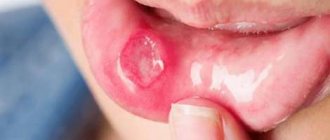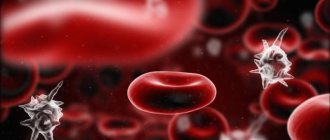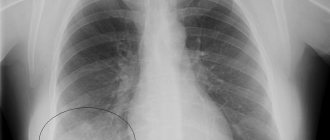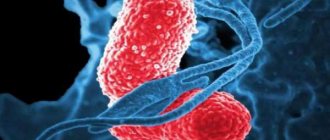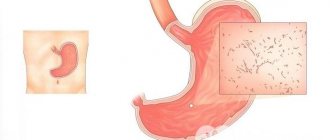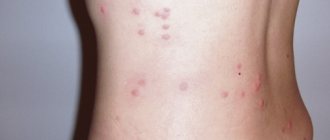Anemia (anemia) is a category of clinical and hematological syndromes, united by the main feature: decreased hemoglobin density in the blood, accompanied by a decrease in the number of red blood cells. The term “anemia” does not indicate a specific disease, since anemia is considered one of the manifestations of various pathologies.
What reasons can cause anemia?
The causes of anemia lie in various areas of a child's life. The disease can be triggered by hereditary factors, occur during gestation, develop against the background of pregnancy pathology, or manifest itself as a result of gene mutation. The list of possible reasons looks like this:
- problems with the functioning of the digestive system;
- liver pathology;
- kidney diseases;
- infection of the body;
- malignant formations;
- large blood loss due to serious injury or after surgery;
- a sharp change in hormonal levels during puberty and intensive growth.
One should take into account the fact that children’s bodies are more vulnerable and susceptible to various negative environmental phenomena and attacks from viruses and bacteria. An imperfect hematopoietic system responds by lowering the level of hemoglobin to infection with worms and poor nutrition (more details in the article: what should nutrition be like for low hemoglobin in children?). Affects the development of anemia and vitamin deficiency, especially with a lack of vitamins such as C, E, B.
Children's doctor Komarovsky notes that anemia in infancy may be associated with physical inactivity. If a baby sleeps a lot, is inactive due to tight swaddling, and is deprived of freedom of movement, then his body slows down the production of red blood cells. Lack of physical activity leads to a decrease in hemoglobin.
Hematogen - a panacea?
Traditionally, hematogen was used to treat anemia. But its use makes sense only as a means to prevent iron deficiency, and not for medicinal purposes. And also when buying a candy bar, you need to pay special attention to what raw materials it is made from. The fact is that iron comes in two types:
- hemic iron, which is found in red blood cells. For production, bovine blood is used, which undergoes special processing. This hematogen is absorbed very well;
- non-heme iron found in plant foods. The digestibility of such iron leaves much to be desired: such a hematogen is practically useless.
Hematogen is a product that contains not only iron, but also amino acids and carbohydrates. It can be considered as a valuable nutritional supplement, but not as a medicine. Hematogen may be harmful to overweight people due to its relatively high sugar content.
What degrees of anemia exist?
Experts divide childhood anemia into 3 main degrees: mild, moderate and severe. The difference in degrees helps doctors choose the optimal direction of treatment and general health measures necessary for the baby’s body to successfully combat the disease. The difference between degrees is based on the quantitative indicator of red blood cells and hemoglobin. For clarity, we have compiled a table:
| Degree of anemia | Hemoglobin level | Red blood cell level |
|
|
|
Symptoms
The clinical picture of the disease is quite vague, since a child suffering from anemia does not have pronounced signs. Only the most attentive parents will be able to suspect the main symptom of the disease - pallor of the skin and mucous membranes. The mild clinical course of the disease does not manifest itself in any way and is diagnosed only with a blood test.
The basis of the symptoms of anemia is a lack of hemoglobin. Anemia in premature babies, in addition to a reduced amount of hemoglobin (up to 90-70 g/l or lower), is also manifested by a decline in bone marrow production.
According to the standards, the lower limit of hemoglobin level in infants and preschool children is 110 g/l, in school-age children – 120 g/l. Until the child reaches one year of age, this norm changes every month from 180-220 g/l in babies from the first week of life.
The course of the disease is gradual. Initially, the child's appetite decreases. The child's general condition may remain unchanged. Later external signs of the disease may appear:
- general malaise;
- sleep disturbance;
- anxiety;
- the skin becomes pale and dry;
- cracks in the corners of the lips;
- noticeable deterioration in hair growth or hair loss;
- lack of weight gain;
- frequent respiratory viral diseases;
- poor functioning of the gastrointestinal tract;
- abnormal physical and psychomotor development.
- dry and clayey stools.
When the next stage of anemia severity occurs, pallor sharply increases, the liver and spleen, as well as lymph nodes, become enlarged, murmurs in the heart and blood vessels are detected, and the temperature may rise. The number of red blood cells at the initial stage of the disease is normal, only the production of hemoglobin is impaired. A little later, the number of red blood cells decreases and hypochromic anemia develops in the child.
It is necessary to focus on the fact that in young children (especially up to one year), as a result of rapid dehydration due to fever, dystrophy or diarrhea, blood thickening occurs and the anemia clinic may go unnoticed.
A child suffering from a severe stage of rickets may develop anemia of particular severity - Yaksh Gayema . In babies under one year old, the cause of this form of anemia may be impaired hematopoiesis.
Autoimmune anemia is sometimes accompanied by jaundice, and in severe cases it provokes the occurrence of hemolytic crises. Hypochromic anemia is manifested in children by shortness of breath, dizziness and flickering of spots in the eyes.
In children under one year old, newborn anemia and nutritional anemia are also observed as a result of improper feeding.
Classification by color parameter
Classification of anemia by color means determining the degree of saturation of red blood cells with hemoglobin. A comparison is made with the norm of 0.8-1.1. Having received the necessary indicators, doctors determine the type of disease:
- The hypochromic form is established when hemoglobin is below 0.8; this group includes iron deficiency anemia and Cooley's anemia (thalassemia). In iron deficiency, hemoglobin production is impaired due to a lack of iron associated with poor diet or significant blood loss. Hypochromic anemia is a frequently diagnosed type in children.
- The normochromic form is stated at a value of 0.8-1.0. It is represented by such forms as hemolytic, aplastic and posthemorrhagic anemia. The hemolytic or sickle cell type is formed when the destruction of red blood cells occurs faster than their production. The posthemorrhagic type is formed after severe bleeding. Aplastic anemia is formed due to severe disorders in the structure of the bone marrow - this is a disease that is difficult to cure and often leads to death. Hypoplastic anemia is associated with minor changes in the bone marrow, and is easier to treat than aplastic anemia.
- Hyperchromic – 1.1. Includes two varieties: pernicious (vitamin B12 deficiency) and folate deficiency. With a lack of vitamin B12, a malignant form of anemia (Addisson-Biermer disease) is formed, leading to serious destruction of the bone marrow and dysfunction of the central nervous system. Folate deficiency anemia refers to a hematological pathology characterized by a lack of folic acid, which affects the synthesis of red blood cells. Folate deficiency anemia is corrected by administering folic acid.
READ ALSO: What is the normal hemoglobin level for an infant?
Classification
According to the mechanism of formation, the disease is divided into:
- primary – this includes physiological anemia in children, which arose as a result of genetic predisposition;
- secondary - in such situations, anemia develops against the background of other pathological processes and unfavorable factors.
In accordance with the pathogenesis, there is the following classification of anemia:
- post-hemorrhagic nature - caused by blood loss, which can be acute or chronic;
- caused by disruption of hematopoiesis;
- caused by the destruction of red blood cells, as well as the predominance of the process of blood destruction over the process of hematopoiesis.
Types of anemia in children caused by inadequate hematopoiesis are:
- hypochromic or iron deficiency;
- sideroachrestic or iron-saturated;
- megaloblastic – this includes B12-deficiency anemia and folate deficiency anemia;
- dyserythropoietic;
- aplastic or hypoplastic anemia.
Types of anemia associated with increased destruction of red substances in the blood:
- membranopathy;
- fermentopathy;
- hemoglobinopathy;
- autoimmune anemia;
- hemolytic disease of the newborn.
In addition, there are degrees of anemia, depending on the severity of the pathology:
- mild - in such situations, children have practically no symptoms. In some cases, there are complaints of slight fatigue and decreased physical activity;
- moderate – has pronounced symptoms, which leads to a significant deterioration of the patient’s condition. In this case, the patient cannot tolerate even the lightest physical activity;
- severe – changes appear in the skin, hair, nails and internal organs.
Severity of anemia
There are also several types of physiological anemia and anemia caused by other disorders, depending on the size of the red blood cells:
- microcentral – volumes are reduced;
- normocentric – without any changes;
- macrocentral - the sizes are increased.
Variants of the course of the disease depending on how saturated the red blood cells are with hemoglobin:
- normochromic anemia;
- hypochromic anemia in children;
- hyperchromic anemia.
How is anemia diagnosed?
If you suspect that your little patient has anemia, consult your pediatrician. Only accurate diagnosis helps specialists reliably identify the extent of the disease. Diagnosis of the disease is carried out through laboratory tests of special tests:
- total blood, revealing the quantitative content of hemoglobin, red blood cells and color indicator;
- blood biochemistry, which determines the amount of vitamins, serum iron, bilirubin;
- They rarely take a bone marrow puncture if other tests have not provided a clear picture of the disease and doctors have doubts.
Having received the results of the study, the doctor builds tactics to combat the disease. The baby may need to see other doctors (nephrologist, rheumatologist, gastroenterologist, cardiologist). The doctor’s primary task is to cure the underlying disease that led to the formation of anemia. Concomitant therapy aimed at eliminating anemia is also prescribed.
Treatment
Hemolytic anemia in children and any other type of disease can be eliminated using conservative medicine. Therefore, treatment may include:
- taking iron or vitamin B12 supplements if they are deficient;
- completing a therapeutic massage course;
- physiotherapeutic procedures, in particular ultraviolet irradiation;
- performing gymnastic exercises, the program of which is drawn up by the attending physician individually for each patient;
- enriching the diet with offal and legumes, herbs and seafood, fresh fruits and vegetables. Formula-fed babies should be given adapted milk formulas. This also includes adjusting the diet of a woman who is breastfeeding;
- the use of medications for etiotropic and symptomatic therapy aimed at eliminating the cause and relieving clinical signs.
In severe cases of the disease, it is necessary to quickly replenish the number of red blood cells, which is carried out through a procedure such as transfusion of red blood cells.
Treatment of anemia due to vitamin B12 deficiency
Iron-deficiency anemia
Let's study a common anemia - iron deficiency. Iron deficiency anemia in children is marked by a decrease in hemoglobin in erythrocytes, a drop in serum iron levels and an increase in its iron-binding properties. For a healthy newborn baby, up to 3 months of age is enough to develop iron reserves obtained in the prenatal state, but after 4 months, infants require more iron. As a rule, the missing amount of iron is obtained from food. A child under 3 years of age requires 8 mg of the element per day, after 3 years - 12-15 mg.
The baby’s body absorbs only 10% of iron from food. In addition, this indicator is influenced by the fact that the quality of products may vary. Fish, chicken, and soy contain a lot of iron; their amount reaches 20-22%. For better absorption of the element, the child is given food containing substances such as copper, fluorine, cobalt, vitamin C, and animal protein. Calcium salts, tetracycline, phytin, and phosphorus interfere with the proper absorption of iron.
Stages of disease development
Experts divide the process of formation of iron deficiency in the body at an early age into three important stages, based on blood counts. A breakdown by stage is necessary for doctors to organize effective treatment of the disease and determine the severity of the disease. The identified stages are described as follows:
- prelatent - iron deficiency is detected, but there are no visible changes in the composition of the blood (serum iron and hemoglobin concentration);
- latent deficiency - the hemoglobin level is normal, but there is not enough serum iron;
- the latter - all blood parameters undergo changes, deviating from the norm.
READ ALSO: how to increase hemoglobin in an infant at home?
What symptoms does it present?
The disease is accompanied by clearly visible symptoms, manifested in the behavior and appearance of the small patient. Parents' attention should be drawn to any deviations from the norm. To help adults, we provide a detailed description of all manifestations of the disease:
- rapid fatigue, frequent headaches caused by chronic fatigue;
- brittle nails and hair loss;
- dysplepsy, perverted change in taste (the child begins to eat chalk or soil);
- shortness of breath after slight physical activity, rapid heartbeat, pale skin.
How is it diagnosed?
The diagnosis of iron deficiency anemia is based on test results. If they show a decrease in hemoglobin to 110 g/l and serum iron below 14.3 µmol/l, and iron-binding serum increases above 78 µmol/l, then the doctor determines the presence of a deficient type of anemia. After making sure that changes have occurred, the doctor develops a treatment method for the patient.
Method of treatment
Treatment of deficiency anemia consists of two areas: taking medications and changing the organization of the son or daughter’s regimen. Parents should ensure that the baby spends more time in the fresh air, receives proper nutrition, does gymnastics, and takes massage courses. Drug therapy consists of taking vitamins and iron supplements.
The medications prescribed to the patient are taken an hour after the baby has eaten. For mild and moderate disease, tablets are prescribed; severe forms are treated parenterally. The main course of treatment is 3-4 weeks and is aimed at achieving obvious improvement. Having eliminated the manifestations of the disease, the specialist prescribes iron supplements in prophylactic doses to the small patient.
When taking iron supplements, additional intake of ascorbic acid, sorbitol, and copper supplements is necessary to improve the absorption of the main drug. Do not use liquids containing calcium and phosphorus (fruit juices, milk, coffee) to take medications. Parenteral administration of iron supplements is justified when the patient is diagnosed with malabsorption syndrome, gastric ulcer, or drug intolerance.
Nutritional Features
A special diet plays a big role in the fight against various anemias. Parents should know which foods contain iron and include them in their child's diet.
- Liver, egg yolk, oatmeal – 5 mg per 100 grams of product.
- Chicken meat, red caviar, apples, beef, oatmeal, buckwheat – 1-4.5 mg per 100 grams.
- Milk, carrots, strawberries – less than 1 mg.
- If you look at the speed and percentage of iron absorption, then the child should increase the consumption of foods such as soy, meat, fish.
Diagnosis of anemia in children
Anemia is diagnosed by laboratory tests.
During a general blood test, special attention is paid to the following indicators and their deviations from the norm:
- hemoglobin level in the blood (a reading less than 110-120 g/l is a reason to consult a doctor);
- level of red blood cells (should be more than 3.8x1012/l);
- color index (norm - 0.85 or more).
More complete information is provided by a biochemical blood test, which reveals the concentration of serum iron in the blood, the levels of transferrin and ferritin in the serum, bilirubin and vitamins.
In some cases, bone marrow tests are additionally prescribed.
It is very important to collect data over time to track the results of taking iron supplements, adjusting treatment as necessary. After laboratory tests, the child can be referred for examination to other specialized specialists: hematologist, gastroenterologist, rheumatologist, cardiologist, etc.
Did you know? A preliminary diagnosis of the presence of anemia in a child can be carried out at home by feeding him beets. If after this the urine changes color to a redder color, you should check the level of hemoglobin in the blood, since with a sufficient amount of iron in the blood, the liver is able to completely process the beet dye.
Deficiency anemias (B12-folate deficiency)
Anemia, which develops due to a small amount of vitamin B12, is associated with insufficient intake of this element from food or due to its poor absorption by the baby’s body. Sometimes B12 deficiency occurs after infection with lancets - worms that consume iron for their reproduction. Symptoms that appear:
- disturbances in the functioning of the gastrointestinal tract and central nervous system, in the process of blood formation;
- severe weakness with little physical activity, palpitations;
- burning sensation of the tongue, signs of glossitis (polished surface) on the tongue;
- yellow skin color;
- enlarged spleen (sometimes liver).
Lack of folic acid affects the normal process of hematopoiesis. The child’s body receives folic acid from foods and is synthesized by intestinal microflora. If its deficiency is detected, then there is a violation in the absorption of acid and folate deficiency anemia is formed. The symptoms of the disease are similar to the case of vitamin B12 deficiency. The only symptom absent is glossitis (polishing of the tongue).
How to treat?
Treatment of anemia in children involves combating the causes that lead to a lack of folic acid. Diseases associated with the gastrointestinal tract are treated and anti-worm medications are prescribed. Acid levels are raised by taking special medications containing vitamin B12 and folic acid. Laboratory tests are periodically conducted to determine whether the levels of the listed elements increase. If progress is made, the dosage of drugs is reduced, but observation is continued.
Treatment of anemia in children
When diagnosing anemia in children, any clinical recommendations should be comprehensive, including a review of nutrition and daily routine, as well as taking iron supplements and vitamin complexes prescribed by a doctor.
Features of nutrition of children with anemia
It should be remembered that the best nutrition for a child under one year of age is breast milk. To prevent anemia in children under one year old, starting from the 8th month, it is important to add meat, cereals, egg yolks, juices, and vegetables to the diet. At the same time, it is necessary to supplement the nursing mother’s diet with iron-containing preparations and vitamin complexes.
If the child receives artificial feeding, switch to specialized formulas enriched with iron and other essential microelements. For older children, special attention is paid to the presence in the diet of such foods as fish, meat (especially red), liver, legumes, buckwheat, cottage cheese, cheese, butter, soups, eggs, nuts (pistachios), vegetables (especially green – spinach, Brussels sprouts, broccoli, parsley, etc.), fruits (apples and pomegranates), berries, dried fruits (dried apricots, prunes, apricots).
Sometimes dietary supplements are prescribed. It is also necessary to review the child’s general daily routine and pay increased attention to walks in the fresh air, which helps enrich the body with oxygen. And also ensure proper healthy sleep according to the schedule, since lack of sleep has a bad effect on the health of children with anemia.
Iron supplements for children
Only the attending physician can prescribe adequate drug treatment that is necessary for your child. Most often these are iron-containing preparations, in the form of iron salts in combination with various acids (malic, ascorbic, amino acid, citric). They break down in the stomach into easily soluble compounds and are most fully absorbed by the body. It is recommended to take separately from meals, with fruit or vegetable juices. And it is important to remember that treatment of iron deficiency anemia in children should last a certain period of time (about 6-10 weeks) and even after reaching the hemoglobin level, it should not be stopped.
Important! If a child is diagnosed with anemia, treatment with nutritional correction ONLY is not recommended. If the level of hemoglobin in the blood drops, taking iron-containing medications prescribed by a doctor is necessary!
In consultation with your doctor, you can supplement the treatment of anemia with traditional methods. To increase the level of iron in the blood, infusions of black currant leaves, strawberries, rowan berries, lungwort, nettle, rose hips, etc. are recommended.
Aplastic and hypoplastic anemia
One of the most complex types of anemia, in which progress is made towards reducing the number of red blood cells, leukocytes and platelets in the bone marrow. The disease leads to the development of hypoplasia or a decrease in the formation of blood cells. Experts consider toxic infection from chemicals and medications to be the main causes of the disease.
Symptoms
Symptoms of the disease appear both externally and in tests. It is not difficult to notice external signs if you closely monitor your baby. Let's list the main ones:
- the number of infectious complications increases, the bleeding of injuries caused by a lack of important blood elements increases;
- a blood test shows a decrease in hemoglobin, platelets and leukocytes, down to a critical figure of 20 g/l;
- examination of the bone marrow reveals an increase in areas filled with fat, areas of hematopoiesis decrease, and the activity of regeneration of new cells decreases.
Treatment methods
Therapy for the disease is complex, including the use of steroid hormonal drugs, the procedure of transfusion of blood and its components.
The treatment plan may include vitamins B12, C, B6 and B2, anabolic hormones, and folic acid. In order to improve cerebral hematopoiesis, glucocorticoids are used to reduce bleeding and suppress the formation of antibodies.
Hemoglobin in children from 6 months to one year: a great thing is the start of complementary feeding!
So, even before birth, the baby borrows from the mother’s body such an amount of iron that allows him to meet his needs for the first 5-6 months. What happens next? How can my child continue to avoid anemia?
Thanks to first complementary foods, which must be introduced into the baby’s diet from 5-6 months. In addition, pediatricians often prescribe a clinical blood test for babies just at the age of six months - in order to know exactly what the child’s hemoglobin level is at the start of complementary feeding.
A clinical blood test performed with a modern hematological analyzer will not only show the child’s hemoglobin level with the greatest accuracy, but will also “tell” what type of anemia “attacked” him - iron deficiency, hemolytic, post-hemorrhagic (after bleeding), etc.
This analysis is especially indicated for those babies whose mothers experienced a lack of hemoglobin during pregnancy but did not take iron supplements.
Depending on what level of hemoglobin the test shows in the child, the doctor will advise:
- or gradually introduce iron-containing “dishes” into the baby’s complementary feeding diet (this option is suitable in the case when hemoglobin has not yet fallen, but has already approached the lower level of normal);
- or (if the mother is still breastfeeding) ask the mother to take appropriate iron supplements;
- or prescribe iron supplements to the child himself (which only happens if iron reserves are completely “zero”, hemoglobin is critically low and there is simply no time to accumulate a new iron reserve in the baby’s body).
Hemolytic anemia
Hemolytic anemia is the result of excessive breakdown of red blood cells. The disease belongs to the hereditary category and is manifested by the following symptoms:
- yellowness of the skin;
- enlarged spleen;
- morphological changes in the structure of red blood cells;
- formation of stones in the gall bladder;
- the formation of reticulocytosis (increased number of reticulocytes in the blood).
Microspherocytosis, one of the forms of hemolytic anemia, is characterized by the formation of trophic ulcers localized in the lower leg area. Ulcers can appear even in infancy. The external manifestation of hyperplasia, when increased formation of cells occurs in the bone marrow, is a malocclusion; the child’s forehead becomes convex and high.
Nutrition of children in the first year: prevention of iron deficiency
A complete and balanced diet for a child in the first year of life, with the timely introduction of foods rich in iron and vitamins that improve its absorption, is the basis for the prevention and treatment of anemia. In the first months of a baby’s life, the main and most complete source of iron is mother’s milk; infants are less likely to suffer from anemia . If the mother did not suffer from gestational anemia during pregnancy, and the fetus managed to accumulate sufficient iron reserves during the gestation period, they are sufficient, provided only breastfeeding, until complementary feeding is introduced. Milk iron is absorbed as actively as possible and has an optimal form for the child. Continuing breastfeeding with the introduction of complementary foods improves the absorption of iron from food products , helping to convert it into a more active form. Depletion of iron and vitamins leads to the need to introduce complementary foods from about 6-7 months of life.
Important
Premature babies, low birth weight babies and those born with signs of IUGR often suffer from anemia, suffer often and for a long time, and are fed with unadapted formulas. Against the background of earlier introduction of complementary feeding, in the period of 5-6 months, they may need additional subsidies of iron in preparations.
The most important food source of iron for children is meat products, but it is better absorbed when combined with vegetable and fruit complementary foods. But dairy dishes inhibit the absorption of iron from food . It is necessary to introduce meat complementary foods even if there is a threat of anemia after 8 months, when digestion is already adapted to new food due to previously introduced vegetable, fruit and cereal complementary foods. Against the background of existing anemia, rice and semolina porridge and oatmeal should be removed from the diet of babies under one year old; buckwheat and wheat are preferable.
How is age related to the incidence of the disease?
The first year of a child is the most vulnerable age for the formation of anemia. The causes of the disease in infants are pregnancy pathologies and hereditary predisposition. If anemia occurs in a one-month-old baby, doctors associate it with poor nutrition and weak immunity. Most cases of anemia in the first months are caused by insufficient amounts of iron and other elements required for normal blood formation.
A large percentage of the disease is detected in infancy and up to 6 months, when the infant’s body selects the initial reserves of useful elements, and their replenishment through food does not occur. Pathology can also manifest itself in bleeding with various etiologies. In addition, medications and worms can cause anemia.
The symptomatic picture of the disease is manifested by its traditional signs. They look like this:
- pale skin and mucous membranes;
- decreased blood pressure, tachycardia;
- shortness of breath from exercise and breathing problems.
Iron deficiency leads to changes affecting hair, nails, and dyspeptic disorders. The child begins to lag behind mentally and physically, behaves overly excited or, on the contrary, looks lethargic. If the infection recurs, the preconditions for the appearance of chronic anemia are formed. Treatment of such a pathology in infants is complicated by the child’s lifestyle and nutrition, when it is difficult to develop a diet for the baby.
Formulas and baby food fortified with iron have been developed especially for infants suffering from this disease. Information about the presence of iron in the product is indicated on the packaging. It is easier for children to fight the disease after one year. The child can be placed on a special diet to ensure normalization of hematopoiesis. However, you should start by eliminating the main factor that caused the disease.
Vegetarian diet and anemia
Iron in plant foods is in a form that is poorly absorbed by the body. This means that every vegetarian will sooner or later experience the symptoms of iron deficiency caused by anemia. To prevent this from happening, you should undergo a course of treatment with iron-containing drugs every six months on an ongoing basis.
To do this, you need to visit a doctor, conduct the necessary tests, and start taking prescribed iron-based medications. If side effects occur during treatment (diarrhea, dark-colored stool, constipation or abdominal pain), the dosage of medications should be halved, and then gradually increased to the normal value.
What complications does the disease manifest?
If the illness is prolonged and the child is not provided with competent medical care, it leads to serious problems in his health. Complications lead to a deterioration in life, affecting the future of the baby. Let's name the most dangerous violations:
- decreased immunity;
- heart failure (failure);
- growth slowdown;
- delays in physical and mental development;
- dysplasia arising in the bone marrow;
- hypoxic coma;
- leukemia;
- formation of a chronic form;
- death.
Note that the iron deficiency form is successfully cured, and the child quickly returns to a normal healthy state. If the changes occurring in the blood are significant and the time to eliminate them is lost, then we can talk about sad consequences, including the loss of the baby. Parents should take the illness discovered in the baby seriously and begin treatment measures on time.
Complications of anemia in children
If a child does not receive proper treatment for a long time, anemia can cause a number of complications that significantly affect the quality of the child’s future life. Among them:
- delayed intellectual and physical development;
- decreased immunity, increased morbidity;
- exposure to various types of infections and somatic diseases;
- problems with the cardiovascular system (heart failure);
- bone marrow dysplasia;
- leukemia, etc.
All these unpleasant consequences can be easily eliminated with timely diagnosis, nutritional correction and medication.
Preventive activities
By taking care of prevention, parents can protect their treasure from a dangerous and complex disease. Working in tandem with a pediatrician, you can easily structure the child’s diet and life so that a dangerous illness does not enter his life. Remember the following:
- Regularly donate your child's blood for general analysis.
- If you have a premature baby, your doctor should prescribe iron-fortified medications. Reception is prescribed for a three-month newborn and continues at 2 years.
- Monitor your one-year-old baby’s diet so that his diet is rich in vitamins and fully balanced in healthy elements.
- Lead a healthy lifestyle with your baby, walk more, play sports, and get stronger.
Early prevention of anemia in children will not require parents to spend a lot of money or radically change their family’s routine. Every parent cares about the health of their child, so it is your duty to take care of the prevention of anemia. If you cannot avoid unpleasant manifestations, do not delay active treatment of your baby. Listen to the advice of Dr. Komarovsky, who insists on immediate consultation with a pediatrician at the slightest symptoms of anemia.
Loading…
Share with friends!
Diagnostics
A pediatrician or hematologist can help treat anemia, make a correct diagnosis and determine the type of disease in children.
The basis of diagnosis is laboratory tests, but often diagnosing anemia in children requires an integrated approach. The first stage involves the clinician performing the following manipulations:
- studying the medical history of not only the patient, but also his close relatives - this will help to find out the causes of iron deficiency anemia and any other type of pathology;
- collection and analysis of the patient’s life history;
- a thorough physical examination of the child - this includes assessing his appearance, measuring blood pressure and listening to the heart rhythm;
- a detailed interview with the patient or his parents - this will enable the clinician to understand how the disease progresses.
For anemia, the following laboratory tests are performed:
- general clinical blood test - to determine the severity of the disease;
- general urine analysis;
- blood biochemistry - will show changes in the composition of such human biological fluid;
- PCR tests and serological tests.
Instrumental activities include the implementation of:
- bone marrow puncture examination;
- trepanobiopsy;
- Ultrasound of the peritoneum;
- ECG.
Based on individual indications, a small patient may be sent for additional examinations to pediatric specialists from more specialized areas of medicine.
Anemia of prematurity
A decrease in hemoglobin and red blood cell levels is often observed in children born prematurely. The prevalence of this condition increases in proportion to decreasing gestational age. Almost all children born before 28 weeks of pregnancy have anemia. It is believed that such a high incidence of anemia is associated with the functioning of the body of a premature baby:
- shorter lifespan of red blood cells;
- rapid increase in body weight and increase in circulating blood volume;
- low level of erythropoietins and insufficient sensitivity of the bone marrow to them.
Repeated blood sampling for various laboratory tests also contributes to its development.
Traditional methods of treatment
There are also folk methods for improving the condition of the body. You can get rid of anemia with the help of simple recipes that contain only natural and healthy products.
If you have anemia, you should try:
- "Cocktail" of juices. By mixing pomegranate, apple, carrot, beetroot and lemon juice and adding a spoonful of honey to the resulting drink, you will provide yourself with a whole set of vitamins for every day. You need to consume 2 tablespoons three times a day.
- Yarrow. Make a decoction by steaming the plant in boiling water. Keep the resulting liquid in the pan for about an hour, after wrapping it in a cloth. Take in the same way as the previous drink.
- Stewed juice. Mix beetroot, carrot juices, and black radish juice. Place the liquid in the oven for an hour, without bringing to a boil. Drink 2 tbsp. spoons half an hour before meals.
- Rowan tea. Take 2 teaspoons of berries, pour 400 ml of boiling water over them. The drink should brew for about half an hour. Drink a glass of tea twice a day. You can make rosehip tea in the same way.
These folk recipes help to consume enough vitamins every day, which helps with anemia. These methods should not be considered a panacea, so be sure to consult your doctor.
About blood functions
To understand what this pathology is, you need to have some understanding of the process of hematopoiesis and the functions of red blood cells and hemoglobin.
Red blood cells are formed and mature in the bone marrow of the spine, skull and ribs, after which they enter the blood and perform their main function - transporting oxygen to the organs and tissues of the whole body. This, in turn, occurs due to the presence of a special protein in them - hemoglobin, which contains iron and is able to bind to oxygen molecules. Having given oxygen to the cell, red blood cells take the resulting carbon dioxide and deliver it to the lungs, where it is released outside.
In a newborn, hemoglobin (Hb) levels are quite high. Since, while in the womb, the child cannot receive oxygen through the air, and there is less oxygen in the mother’s blood than in the environment, the increased level of hemoglobin compensates for this problem. In the first days, the norm for hemoglobin in a baby is considered to be 180-240 g/l.
Red blood cells play a critical role in oxygen transport
The life cycle of red blood cells is 4 months or slightly less. After this, the cells are destroyed in the liver and spleen, but new ones take their place, so that the process of transporting oxygen and removing carbon dioxide in the blood is not interrupted.
How to identify pathology
As a rule, anemia in an infant is detected only after a general blood test, the results of which show that the hemoglobin level is reduced. Normally, its amount should not fall below 110 g/l. This is the main symptom.
Additional signs of anemia include:
- poor appetite;
- weakness of the body;
- lack of weight gain required for a certain age;
- pallor and roughness of the skin;
- sweating;
- frequent regurgitation;
- poor sleep;
- brittleness of hair and nails;
- delayed psychomotor and physical development;
- cracks form in the corners of the mouth;
- older children have a desire to eat earth or clay.
The older the child becomes, the stronger all of the above symptoms begin to appear.
Early anemia in premature babies is accompanied by the same symptoms and appears 4-10 weeks after birth. But late anemia manifests itself only after 3-4 months and can be accompanied by the following symptoms:
- dry skin;
- poor appetite;
- an increase in the size of the spleen and liver (detected by ultrasound of the abdominal cavity).
Diagnosis of deficiency anemia in children is performed only using a blood test. It is impossible to make an accurate diagnosis based on any external signs. After the blood test shows that the hemoglobin level and the number of red blood cells are less than expected, additional diagnostics are prescribed that will help identify the exact type of pathology and its degree. This:
- blood biochemistry;
- urine analysis (clinical);
- general stool analysis.
Additional diagnostics also include bone marrow puncture (if necessary, histological examination).
Possible reasons
The development of anemia in children is caused by various factors - external and internal, hereditary and acquired, intrauterine and neonatal, natural and pathological. Parents should know what reasons can cause such a dangerous pathology in order to protect their baby from harm in time.
Problems of intrauterine development:
- anemia, rubella in the mother during pregnancy;
- improper development of the umbilical cord, placenta;
- difficulties with placental blood flow;
- smoking;
- Rhesus conflict.
Neonatal difficulties:
- birth injuries;
- delayed/premature umbilical cord tying;
- prematurity;
- low body weight;
- congenital, hereditary diseases that destroy red blood cells.
Nutrition:
- predominance of dairy products;
- monotonous diet;
- vegetarianism;
- lack of vitamins;
- lack of regime.
Diseases:
- helminthic infestations;
- rickets;
- oncology;
- intestinal diseases;
- hepatitis;
- infections: tuberculosis, lung abscess, bacterial endocarditis, brucellosis, pyelonephritis, osteomyelitis, mycosis;
- systemic lupus erythematosus;
- Horton's disease.
Anemia can also develop in a child due to an unfavorable environment or large blood loss due to injury or unsuccessful surgery. Not only the course of treatment, but also prognoses for the future will depend on the causes of this pathology.
If hepatitis has led to the aplastic form of the disease, there is very little chance of survival. And if the baby has simply not been eating well for a long time and has iron deficiency, if the pathology is not advanced, everything can be corrected. The main thing is to recognize in time that something wrong is happening to him.
Komarovsky's opinion. A well-known pediatrician calls physical inactivity the main cause of anemia in infants. If he constantly sleeps, tightly wrapped and deprived of physical activity, his body will have no need to produce red blood cells. Hence the low level of hemoglobin.
The importance of iron for a child’s body
Iron is a very important microelement for the body: it is used in the synthesis of enzymes and proteins that take part in metabolic processes.
One of the important blood proteins that contains iron is hemoglobin (Hb). It is Hb, combining with oxygen, that ensures its delivery to various tissues. With a lack of iron and hemoglobin, hypoxia (oxygen starvation) develops in all organs and systems. Lack of oxygen is especially unfavorable for the brain.
Iron is found in myoglobin, catalase, cytochrome, peroxidase and other enzymes and proteins. The body's iron reserves are created in the form of hemosiderin and ferritin.
At the stage of intrauterine development, iron enters the fetus through the placenta from the mother's body. This process, which creates a reserve of iron in the fetal body, becomes most intense during pregnancy 28-32 weeks.
At birth, the neonatal iron reserve (depot) is 300-400 mg in a full-term infant, and only 100-200 mg in a premature infant.
Iron from this reserve is used for the synthesis of hemoglobin and enzymes, participates in regenerative processes, and compensates for physiological losses in urine, sweat, and feces.
Intensive growth and development of a child increases the need for iron. This is why iron reserves are depleted quite quickly: in a full-term baby by 5-6 months, and in a premature baby by 3 months.
Absorption of iron from food occurs in the intestine (in the duodenum and jejunum). Only 5% of the iron consumed daily is absorbed from foods. Its digestibility depends on the state of the digestive tract. The main source of iron is meat products.
Research and diagnostics
It is not easy to suspect iron deficiency at the prelatent stage. There are no visible changes, and only very attentive parents can pay attention to changes in the child’s behavior. It is not always easy to determine the disease even at the latent stage, but sensitive mothers and fathers usually turn to a pediatrician during this period.
It is impossible to make an accurate diagnosis based on external signs and medical history alone. Whether it really is iron deficiency anemia or another ailment can be determined by conducting biochemical laboratory blood tests.
One of the diagnostic criteria is the amount of hemoglobin Hb in the blood. The table shows Hb values for different degrees of the disease:
| No. | Degree of iron deficiency anemia | Amount of Hb, g/l |
| 1 | light | 91-110 |
| 2 | average | 71-90 |
| 3 | heavy | 51-70 |
| 4 | super heavy | below 50 |
At the latent stage, an analysis of the total iron-binding capacity of serum is used for diagnosis. Its indicators during the disease exceed 63. In addition, the shape and size of red blood cells change. They shrink and take on a pear-shaped, crescent-shaped shape.
The table shows other indicators of the biochemical composition of the blood characteristic of iron deficiency anemia:
| No. | Index | Meaning |
| 1 | Iron saturation of red blood cells | Below 0.86 |
| 2 | Serum iron level | Below 14 µmol/l |
| 3 | Ferritin | Less than 12 µg/l |
To determine the causes of the disease, the pediatrician may prescribe a stool test for the presence of blood and parasite eggs. If necessary, a bone marrow puncture is performed. Hardware examinations may include abdominal ultrasound and colonoscopy.
How to get rid of the disease
Treatment of anemia in young children, as a rule, consists of completely eliminating the causes and symptoms that led to the development of this pathology. If the disease is the result of diseases that are accompanied by bleeding, then they are diagnosed and treated.
Mild degree
If the disorder is mild, the baby is prescribed a special diet. If he eats formula, then a specialized formula enriched with iron is prescribed. When breastfeeding, the mother is responsible for adjusting her nutrition. Her diet is as follows:
- consumption of yolk, fish, meat (chicken, rabbit, beef);
- introducing fresh vegetables into the diet that contain iron: lettuce, green onions, Brussels sprouts, parsley, spinach;
- often eating walnuts, milk, cod liver.
In other words, a nursing mother must monitor her diet - it must be balanced and contain large amounts of iron and other microelements.
Babies whose diet already includes complementary foods should limit feeding them to cereals - no more than once a day. The exception is buckwheat porridge. In the presence of inflammatory processes, as well as in cases of gastrointestinal dysfunction, infants are allowed to give a decoction of rose hips, chamomile or mint.
Average degree
In addition to improving nutrition, anemia in children needs to be treated with special drugs that restore the level of substances that are lacking in the body, especially for degrees 2 and 3 of the disease. If iron levels are insufficient, iron supplements are prescribed. For example:
- ferrum lek;
- hemoferon;
- ferroplex;
- orferon;
- actiferrin;
- conference.
An improvement in the child's condition and restoration of normal hemoglobin levels is observed after 3-4 weeks from the start of the administration of drugs and adherence to the diet. Complete recovery of iron deficiency occurs after 3-6 months. To eliminate the possibility of relapse of the disease, it is necessary to continue the course of treatment even after normalization of hemoglobin levels, reducing the daily dose by half.
As an addition to the main treatment, the doctor prescribes multivitamin preparations. If, according to the results of the analysis, there is a lack of folic acid, then medications containing it are prescribed.
Severe degree
Severe anemia must be treated in a hospital setting under the supervision of a physician. With this form of pathology, the baby may experience serious consequences: dystrophy, oxygen starvation, impaired renal and liver function. Therefore, treatment must be more serious and faster. For this purpose, the parenteral method of administering iron supplements is used, i.e. a method in which the medicine bypasses the gastrointestinal tract.
Basically, a child under one year of age is prescribed intravenous administration. In especially severe cases, red blood cell transfusion procedures are necessary, which is done for anemia in very premature babies (for example, those born at about 30 weeks).
Prevention of anemia in children should begin already during pregnancy. The expectant mother must definitely monitor her diet, follow a diet, often walk in the fresh air, and, if necessary, take iron-containing mineral and vitamin complexes. After the birth of a baby, the prevention of anemia is natural feeding, good care, timely testing (diagnosis), and observation by a pediatrician.
At the first suspicion of anemia, you should not delay treatment - the sooner it is started, the lower the risk of developing more severe degrees of disease and other consequences.
Anemia - what is it and why is it dangerous in newborns?
With a low level of hemoglobin in the blood, which is the building material for red blood cells, anemia develops. Red blood cells, or erythrocytes, transport oxygen to all cells of the human body. Almost 98% of their composition is protein (globin) and iron.
The lack of this element in the body of newborns leads to a delay in the development of brain structures and severe immunodeficiency. At the first signs of anemia, you should immediately contact your pediatrician, since at the initial stage anemia can be corrected quite easily. Moderate and severe degrees of this disease require careful adherence to the pediatrician’s recommendations.
In infants, anemia may not show any obvious signs. The disease can only be indicated by the results of a blood test when the hemoglobin content in them is below 110 units.
Symptoms of anemia noticeable to parents of infants:
- Restless sleep, daytime drowsiness;
- Lethargy and moodiness;
- Desire to eat inedible objects (clay, sand, earth);
- Complete lack of appetite;
- Hair loss, poor growth;
- Spitting up for no reason;
- Cracks in the corners of the lips;
- Frequent colds;
- Dyspeptic manifestations, disruption of the gastrointestinal tract;
- Stomatitis;
- Brittle nails;
- Increased sweating.
If a child exhibits similar symptoms, the doctor will order a general blood test. The norm of hemoglobin in a newborn child is 200 g/l, in a child up to six months old – 100 g/l, over 6 months – 140 g/l.
If the child's test results are noticeably behind the norm, a pediatrician should be consulted.
Prognosis and prevention
Prevention of Fe deficiency begins during pregnancy. Anemia in mothers leads to a lack of microelements in the embryo, which affects the formation of an iron-containing depot. A pregnant woman should eat well and nutritiously, and, if necessary, create a diet together with a doctor.
Dr. Komarovsky advises immediately after the birth of a newborn to feed him breast milk for at least 6 months. This is the best prevention for many diseases. Complementary foods should be introduced only under the guidance of a pediatrician and at the slightest reaction of the child’s body, immediately return to breastfeeding or change the product.
At risk are premature babies and twins, as well as those who experienced placental abruption or infectious lesions of the mother during embryogenesis. They are closely monitored by neonatologists.
As your one-year-old child grows and especially during adolescence, you need to carefully monitor your diet. It should be rich in vitamins and minerals, not just iron.
A favorable outcome of the disease depends on timely access to a doctor. The sooner parents notice changes in the child’s behavior and development, the sooner they can begin therapy. It is normal to consult two or three doctors if the previous doctor’s explanation of the baby’s condition seemed dubious.
In the initial stages of development, iron deficiency anemia is highly treatable. Fe deficiency can be easily compensated by changing the baby's diet. External manifestations do not go away so quickly, but with timely treatment and adequate treatment, not a trace remains of them.
If the disease is not treated, it can lead to serious consequences. Degenerative processes occur in tissues experiencing hypoxia. This especially affects a growing organism. The most harmful effects are on the brain and central nervous system. The child is lagging behind in physical and mental development. It is almost impossible to catch up with peers in the absence of therapy.
Treatment with medications
There are protocols for the treatment of anemia that doctors rely on. After the form and severity of the disease has been established, the doctor, based on this protocol, makes recommendations for treatment.
So, if it has been determined that a child has mild iron deficiency anemia, they are limited to nutritional correction. Children who are breastfed and are ready for complementary foods are introduced to the diet with meat and vegetable puree, egg yolk, liver, buckwheat, and rosehip decoction. A nursing mother is prescribed to take multivitamins containing iron or separately containing iron preparations.
Iron-containing products
For babies who, for some reason, are not breastfeeding, a careful selection of a highly adapted formula enriched with iron is carried out. In parallel, the treatment regimen includes taking multivitamins or B vitamins, as well as folic acid.
If a chronic disease that contributes to the development of an anemic condition is identified, the root cause is treated. Thus, for diseases of the gastrointestinal tract, medications are used that improve intestinal motility, relieve spasms, and normalize intestinal microflora. Herbs with an anti-inflammatory, wound-healing effect are recommended, for example, teas from decoctions of chamomile, sage, mint, and rose hips.
For severe hemolytic anemia, the administration of glucocorticosteroids, immunosuppressants, and plasmapheresis is indicated. In some cases, the spleen has to be removed.
For moderate anemia, iron supplements can be prescribed, but it is worth remembering side effects such as constipation, stomach pain
It should be remembered that even mild anemia, no matter how old the child is, can only be treated by a doctor. Self-medication is unacceptable!
Iron supplements should only be prescribed by a doctor, and the doses should be calculated specifically for your child. Do not prescribe the dose on your own. The use of medications should be carried out mainly 30 minutes before meals, as indicated in the instructions. It happens that they cause nausea or even vomiting.
During treatment, blood tests are taken regularly so that trends in the baby’s condition can be easily tracked. Anemia must be treated until the end of the course so that the child’s body can create a certain supply of iron.
The main symptoms of the initial stage of anemia
The degree of anemia is not the only criterion for classifying this condition.
There are five main types of anemia, the manifestations of which have both common features and some differences:
- B12 deficiency and folate deficiency. A deficiency of this vitamin in the body is manifested by mild itching, usually in the area of the fingers and toes. The tongue also suffers: its surface becomes inflamed and a burning sensation appears. The skin acquires a yellowish tint, which is why the disease can be confused with jaundice. The main symptom of B12 deficiency is numbness in the limbs and a slight tingling sensation. Folic acid deficiency leads to fatigue, irritability, and decreased appetite.
- Iron deficiency. Iron deficiency manifests itself through a constant loss of strength and shortness of breath during physical exertion. With iron deficiency anemia (IDA) of the 1st degree, the following symptoms appear: dry skin, tingling on the surface of the tongue, slight tachycardia, paleness of the face and limbs. Ferrum deficiency also leads to hair loss and brittle nails.
- Aplastic (develops due to insufficient formation of red blood cells in the bone marrow). A mild degree is manifested by decreased performance, frequent dizziness and malaise. There is a feeling of lack of air, tinnitus, and rapid heartbeat. A characteristic manifestation of this type of anemia is easy bruising, bleeding gums, and nosebleeds.
- Hemolytic (mainly caused by hereditary pathologies, in which increased destruction of red blood cells is observed). Main manifestations: constant weakness, shortness of breath, tachycardia, bleeding gums. Mild pain may appear in the left hypochondrium, arising due to the fact that the bulk of red blood cells are destroyed precisely in the spleen.
- Posthemorrhagic (anemia after bleeding). It can be acute or chronic. Acute is easily detected, as it occurs after large blood losses. Chronic can be a consequence of minor bleeding (from stomach ulcers or menstrual ulcers), often causes the development of iron deficiency and develops into iron deficiency. The main symptoms: weakness, pale skin, decreased performance, shortness of breath.
As stated earlier, you can determine whether you have anemia and its type only based on laboratory data.
Diet
What foods in a nursing mother’s diet will help eliminate mild anemia in a baby?
First of all, these are pork and beef liver, chicken egg yolk, veal kidneys, sesame seeds, seaweed, oysters, legumes, chickpeas (chickpeas), buckwheat, nuts. But when adjusting her menu, a nursing mother should not forget that in addition to iron, potential allergens can also get into breast milk. For this reason, carefully introduce foods such as beans, peas, nuts and some others into your diet.
Disease prevention
Treatment of anemia also includes preventive measures. These include:
- varied and healthy diet (vegetables, meat, chicken egg yolk, fish, seasonal berries, rose hip decoction)
- good sleep
- walks in the open air
- absence of smokers around the child
- Regular examination by a doctor with a blood test for hemoglobin levels
For the maturation of red blood cells in the body, folic acid is especially necessary. It is found in spinach, asparagus, beans, liver, egg yolk, and cheese. If folic acid is deficient, it can also be supplied to the body in the form of tablets. A deficiency of this substance in children manifests itself in the form of poor weight gain, poor development of reflexes, and developmental delays.
Folic acid is prescribed to pregnant women in the early stages so that the neural tube of the fetus develops normally. If there are symptoms of anemia in children, folic acid is prescribed from an early age along with iron supplements.
Hemoglobin: normal
Depending on the age of the child, the lower limit of normal hemoglobin is in the following values:
- 130 g/l – from birth to 3 months;
- 100-110 g/l - from three months to a year;
- 110 g/l – from one to three years;
- 115 g/l – from 4 to 12 years;
- 120 g/l. – from 12 years old.
Although for a child in the first three years of life, a hemoglobin level of 110 g/l is within the normal range, this condition is considered pre-anemic by pediatricians.
Normal hemoglobin levels depend on the child’s age:
- from birth to the end of the first day - no less than 145 g/l and no more than 225 g/l (grams per liter);
- from the beginning of the second day to the end of the 13th day - 125 - 205 g/l;
- from 14 days to 28 days – 120 – 180 g/l;
- from one month to 6 years – 110 -140g/l.
It is worth considering that small deviations from the norm in one direction or another are acceptable and are an individual indicator.
The amount of iron in a baby’s body is quite large until approximately 6 months. All this time, the reserves deposited while in the mother’s womb are consumed. After this, the child must replenish them from the outside. If iron is supplied in small quantities through food, the baby may show signs of iron deficiency. Also, the causes of anemia in children may be intrauterine in nature:
- poor nutrition of a woman during pregnancy;
- lack of vitamin B12, folic acid and copper during pregnancy;
- underdevelopment of the umbilical cord and placenta;
- bleeding occurred during pregnancy;
- iron deficiency in the expectant mother;
- pathologies of intraplacental blood flow;
- intrauterine fetal hypoxia;
- multiple pregnancy;
- consequences of fetal intoxication.
In addition, a lack of hemoglobin can occur after a child receives a birth injury, with prematurity, and even as a result of early or late ligation of the umbilical cord. Anemia in premature babies occurs in 90% of cases of premature birth. Moreover, the shorter the gestational age of pregnancy, the higher the degree of pathology. Iron deficiency anemia in children can cause the formation of acute iron deficiency in young children.
After birth, the causes of anemia can be:
- diseases leading to impaired absorption of iron;
- transferring the child to artificial feeding;
- infections during which bleeding is possible;
- too rapid growth of bone tissue and muscles;
- disturbances in the synthesis of red blood cells;
- feeding with whole milk;
- chronic diseases;
- lead poisoning;
- lack of manganese and copper, which allow iron to be converted into hemoglobin;
- hematological and hereditary diseases.
Causes of anemia
Anemia caused by iron deficiency is most often diagnosed in young children; it is also called hypochromic anemia.
The main reasons for this violation include the following:
- Violation of the principles of balanced nutrition.
- Poor nutrition of the mother during pregnancy, which led to an insufficient supply of iron in the baby after birth.
- Immaturity of systems and organs as a result of prematurity.
- Early weaning and switching to artificial nutrition.
- Acute inflammatory processes.
- Diseases of the gastrointestinal tract.
- Infectious diseases in acute form.
How does anemia appear in infants? The reasons for its development can be very diverse.
Prenatal period
During intrauterine development, the baby needs to accumulate a certain amount of iron in order to form a kind of depot (approximately 300 mg). The most active period of iron transfer from mother to fetus occurs at 28-32 weeks of pregnancy. Therefore, any problems at the beginning of the third trimester (gestosis, chronic diseases of the mother, fetoplacental insufficiency, bleeding, premature placental abruption, as well as low hemoglobin in the mother herself) can interfere with the absorption and accumulation of iron, and therefore contribute to the development of anemia in infants.
Children born prematurely or from multiple pregnancies are at risk. In the first case, they do not have time to replenish their reserves of microelements, and in the second they have to share with a brother or sister
During childbirth
The situation can become more complicated if there is blood loss during the birth itself (for example, with premature placental abruption) or if traumatic obstetric aids were used. An untied or poorly treated umbilical cord also leads to bleeding.
After childbirth
Internal factors due to which postpartum anemia develops are as follows:
- hemolytic disease - occurs due to incompatibility of the blood of mother and fetus according to the ABO system or Rh conflict; the destruction of fetal red blood cells often begins in the womb and can lead to the death of the baby;
- bone marrow failure, when it partially fails to perform its functions of producing normal blood cells;
- pathologies in hemoglobin production;
- any infectious or chronic diseases (food allergies, diathesis, gastrointestinal bleeding, pyelonephritis, helminthic infestations);
- hereditary diseases (cystic fibrosis, celiac disease, lactase deficiency).
All reasons can be divided into 2 categories:
- Causes of anemia before 3 months of age (congenital).
- Causes of anemia after 3 months of age.
What reasons can cause such a serious problem?
First, let's look at the reasons included in the first group:
Mother's nutrition during pregnancy.
Nutrition during pregnancy is very important for the baby. At the end of the second - third trimester, the expectant mother's hemoglobin level in the blood begins to drop sharply, which can lead to oxygen starvation of the fetus. To avoid this, the expectant mother should carefully monitor the level of hemoglobin in the blood, take more foods high in iron, and special medications (Sorbifer, Totema, Ferlatum).
Infectious disease of the mother.
The infection can pass to the child from the mother, even despite the barrier protection of the placenta. As a result of the negative impact of the infection, the supply of iron to the baby is blocked, which leads to iron deficiency.
The baby was born prematurely.
According to statistics, premature babies are more likely to suffer from iron deficiency anemia.
Feeding.
In babies under three months of age, iron deficiency can occur due to an improperly organized feeding process or an unbalanced diet of the mother, and even the method of feeding can play a key role in this issue. Thus, formula-fed infants are more susceptible to developing anemia. If the analysis shows a low level of hemoglobin in your baby, then it is worth choosing a special mixture that contains a larger amount of iron.
I recommend reading: What should a mother’s diet be like while breastfeeding a newborn?
As for breastfeeding, the mother should carefully monitor the level of iron in her body. In addition, you need to enrich your diet with healthy foods, organize split meals in small portions, and also, if necessary, take iron-containing supplements.
Large loss of blood from the mother during childbirth.
If a mother experiences significant blood loss during childbirth, her beloved baby may develop iron deficiency anemia.
There are also reasons such as:
- pathologies or disturbances in the functioning of the placenta;
- folic acid deficiency (more in the article: What is the danger of a lack of folic acid during pregnancy?);
- Rh conflict between mother and fetus.
READ Internal bleeding - causes, symptoms, diagnosis and treatment
Above I described the reasons that are possible in newborns up to 3 months, then we will consider the reasons for older children:
- a low-weight child (insufficient weight gain and poor appetite may well provoke a similar problem);
- decreased intravascular pressure;
- gastrointestinal problems;
- a real sleepyhead (if the baby constantly wants to sleep, then the risk of “lack of receipt” of beneficial microelements and vitamins, including iron, increases).



